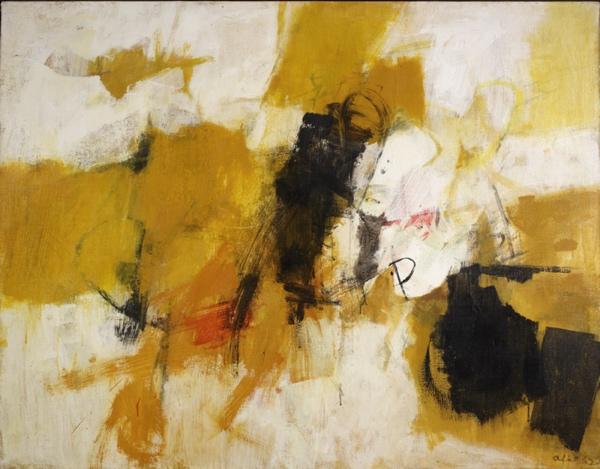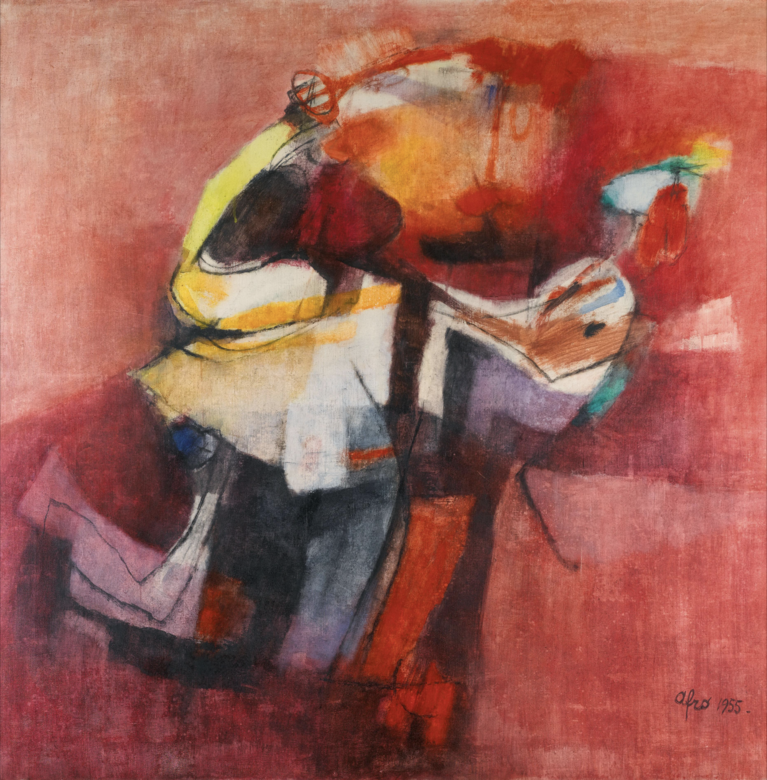
Afro in his studio in the Castello di Prampero, near Udine, 1963. Photo: Italo Zannier
Afro Libio Basaldella, known as Afro, was born in Udine, Italy, 4 March 1912. With his brothers Dino and Mirko, aged only 16, he exhibited paintings at the only Mostra della Scuola Friulana d’Avanguardia (1928). In 1930, he was awarded a scholarship by the Marangoni Art Foundation of Udine, which enabled him to move to Rome with his brother Dino, and engage the art scene there, specifically that of the Scuola di via Cavour and the Scuola Romana. From 1931, he took part in various Mostre Sindacali and in 1933 exhibited at the Galleria Il Milione in Milan with fellow Friulan artists, Bosisio, Pittino and Taiuti. Later, Afro moved permanently to Rome. In 1935 his work was shown at the 2nd Rome Quadriennale, and in 1936 at the Venice Biennale to which he was invited again in 1940 and 1942. Following his experience with the Scuola Romana, he painted several large murals. He passed the war years in Venice. In the late 1940s he developed his distinctive version of abstraction from a combination of neo-Cubism and the metaphysical painting of de Chirico.
In 1950, Afro travelled to the United States and began his almost twenty-year collaboration with the Catherine Viviano Gallery, New York. The different cultural climate in the USA and the American avant-garde of the period made a strong impact on Afro. This influence, however, appeared only later in his work, and was expressed in a personal manner. In 1952, Afro was part of the Gruppo degli Otto, whose members exhibited at the XXVI Biennale. In 1955, he was invited to exhibit in the first Documenta in Kassel, in the Rome Quadriennale, and in a traveling exhibition in the USA, The New Decade: 22 European Painters and Sculptors. By this time, Afro had achieved international fame and recognition. In 1956, he was awarded the prize for best Italian painter at the Venice Biennale. In 1958, together with Appel, Arp, Calder, Matta, Miró, Moore, Picasso and Tamayo, he was selected to decorate the new UNESCO Headquarters in Paris. His contribution was a mural entitled The Garden of Hope.
Afro continued his international career in 1959-60: he exhibited at the second Documenta in Kassel, and won the Carnegie prize in Pittsburgh, as well as the Italian prize of the Guggenheim International at the Solomon R. Guggenheim Museum in New York. In 1961, James Johnson Sweeney, former director of the Guggenheim Museum, New York, wrote an essay for a monograph on his work. During this period, Afro held solo exhibitions in Cambridge, Massachusetts Institute of Technology (1960), the Galerie de France in Paris, and the Galleria Blu in Milan (1961). In 1964-65, he was given a series of European exhibitions: the Galerie im Erker in St. Gallen, the Räber in Lucerne, the Günter Franke in Munich, and in 1969-70, a large retrospective exhibition curated by Bernd Krimmel at the Kunsthalle in Darmstadt, the Nationalgalerie in Berlin, and later, at the Palazzo dei Diamanti in Ferrara.
Following the death of his brother, Mirko in 1969, Afro suffered various periods of ill-health.
During the 1970s, Afro focused mainly on printmaking, concentrating less on painting. He participated in fewer exhibitions. Afro died in Zürich, 24 July 1976. A monograph edited by Cesare Brandi was published the following year. In 1978, the Galleria Nazionale d’Arte Moderna in Rome paid homage to Afro with a large retrospective exhibition, curated by Bruno Mantura.
Numerous solo and collective exhibitions were held in the years that followed, and extensive research by art historians and critics consolidated Afro’s renown, contributing to the ongoing di usion of his work, in Italy and abroad. Awareness of Afro’s art grew and continues to grow over time, thanks also to the revival of interest in the various historical contexts, more than half a century ago, in which he played a role, as an in Italian painter of international renown.
Site internet et réseaux sociaux
Tornabuoni Art

